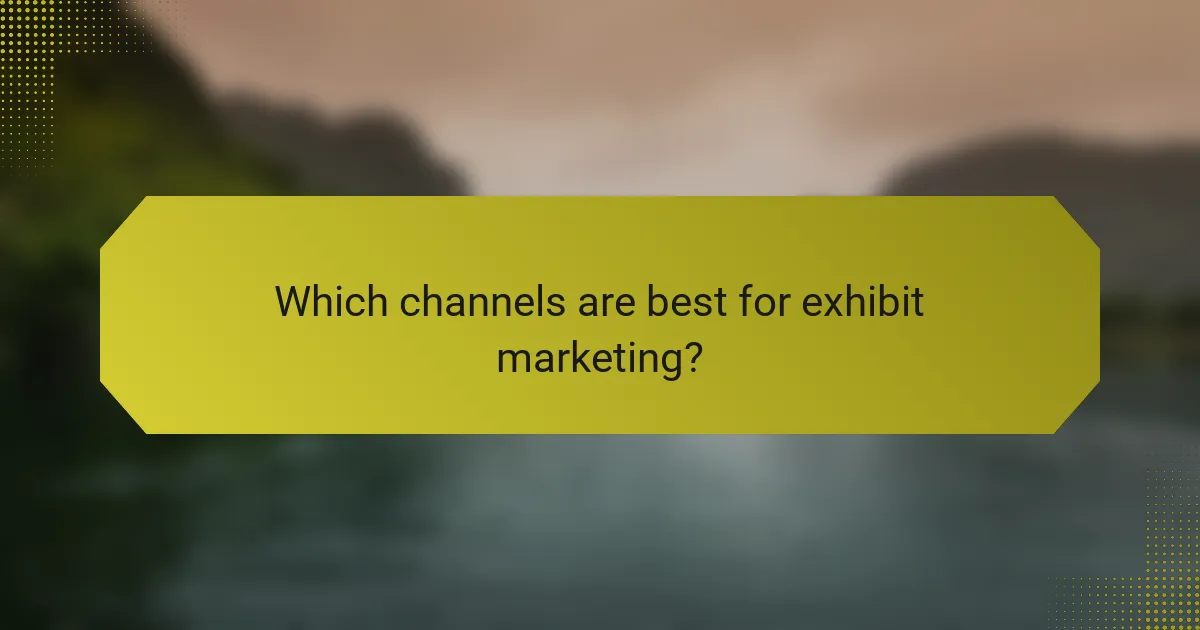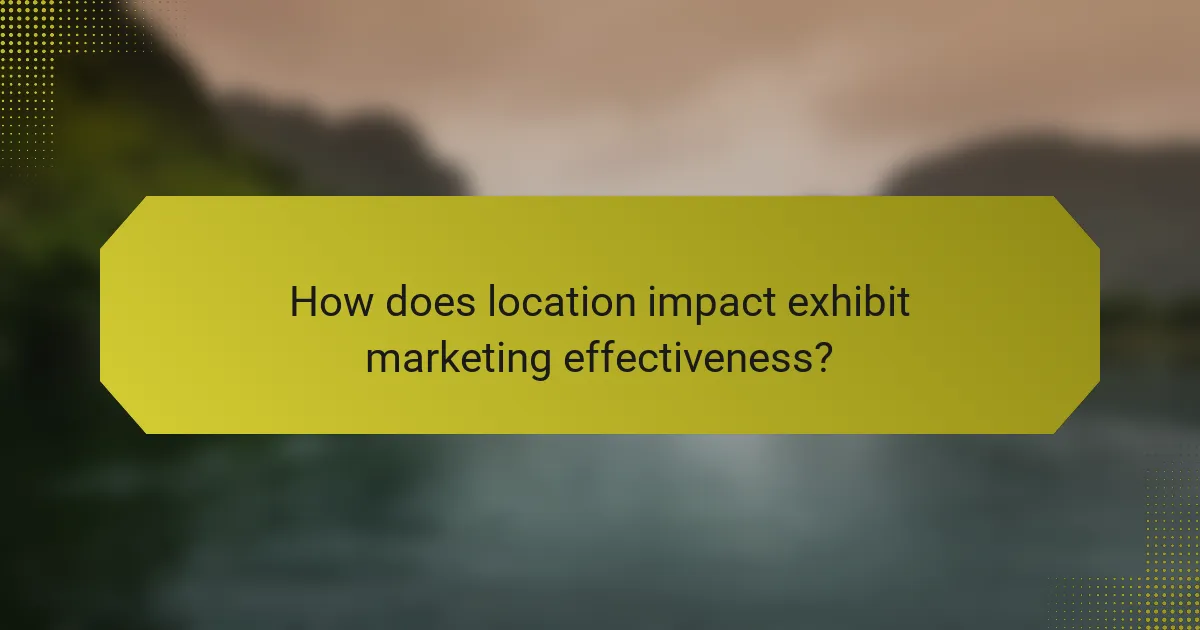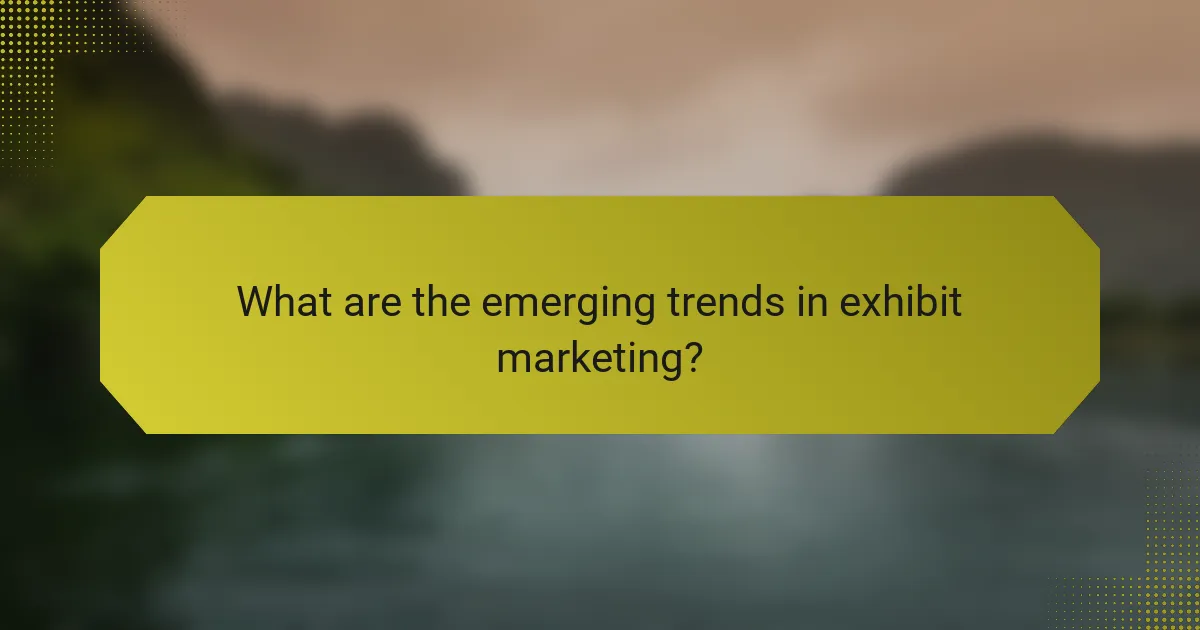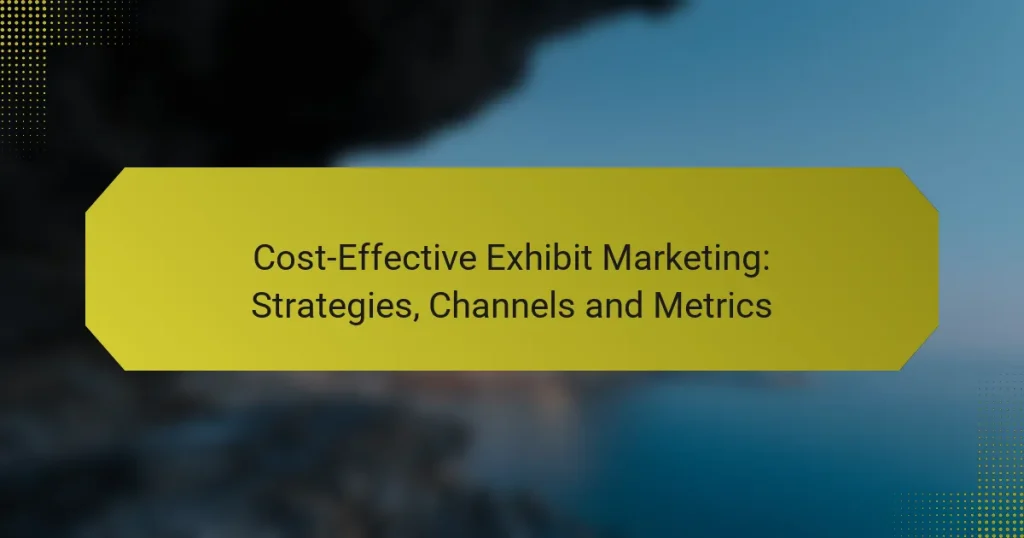Cost-effective exhibit marketing strategies aim to enhance visibility and engagement while keeping expenses low. By utilizing digital channels and innovative methods, businesses can connect with their target audience efficiently. To gauge success, it’s essential to measure metrics such as lead generation, attendee engagement, and return on investment (ROI). Various channels, including trade shows, webinars, social media, and email campaigns, provide unique opportunities to achieve specific marketing objectives.

What are cost-effective exhibit marketing strategies?
Cost-effective exhibit marketing strategies focus on maximizing visibility and engagement while minimizing expenses. By leveraging digital channels and innovative approaches, businesses can effectively reach their target audience without overspending.
Utilizing social media platforms
Social media platforms are essential for promoting exhibits and engaging with potential attendees. Use channels like Facebook, Instagram, and LinkedIn to share updates, behind-the-scenes content, and live event coverage. Regularly posting engaging content can significantly increase your reach and interaction.
Consider running targeted ads on these platforms to reach specific demographics. Set a budget that aligns with your goals, and monitor the performance to optimize your campaigns effectively.
Leveraging influencer partnerships
Partnering with influencers can amplify your exhibit’s visibility and credibility. Identify influencers within your industry who resonate with your target audience and can authentically promote your event. This collaboration can include social media posts, blog features, or even live appearances at your exhibit.
Ensure that the partnership is mutually beneficial by offering incentives, such as exclusive access or promotional opportunities. Track the engagement generated from these partnerships to assess their effectiveness.
Implementing email marketing campaigns
Email marketing remains a powerful tool for reaching potential attendees. Create targeted email campaigns that highlight your exhibit’s unique offerings, schedule, and any special promotions. Personalization can enhance engagement, so segment your audience based on their interests.
Utilize compelling subject lines and clear calls to action to encourage recipients to register or learn more. Monitor open and click-through rates to refine your approach for future campaigns.
Creating engaging content for virtual events
For virtual events, creating engaging content is crucial to maintain attendee interest. Use a mix of formats, such as webinars, live Q&A sessions, and interactive polls, to keep participants involved. High-quality visuals and professional presentations can enhance the overall experience.
Promote this content across your marketing channels to drive attendance. Consider recording sessions for on-demand access, allowing attendees to revisit valuable information at their convenience.
Optimizing booth design for impact
An impactful booth design can attract more visitors and enhance their experience. Focus on creating an inviting space with clear branding, engaging visuals, and interactive elements. Use technology, such as touchscreens or VR experiences, to draw in attendees and provide them with memorable interactions.
Ensure that your booth layout facilitates easy navigation and encourages conversations. Regularly assess visitor flow and make adjustments as needed to maximize engagement during the event.

How can I measure the effectiveness of exhibit marketing?
Measuring the effectiveness of exhibit marketing involves evaluating various metrics that reflect performance and engagement. Key areas to focus on include lead generation, attendee engagement, and return on investment (ROI).
Tracking lead generation metrics
Lead generation metrics are crucial for assessing how well your exhibit attracts potential customers. Common metrics include the number of leads collected, the quality of those leads, and conversion rates post-event. Aim to track how many leads convert into sales within a specific timeframe, typically ranging from a few weeks to several months.
Utilizing tools like lead retrieval systems can streamline this process. These systems often allow you to scan badges or collect contact information digitally, making it easier to quantify your leads accurately.
Analyzing attendee engagement levels
Attendee engagement levels indicate how effectively your exhibit captures interest and fosters interaction. Metrics to consider include booth traffic, time spent at your exhibit, and the number of interactions per visitor. Engaging presentations or interactive displays can significantly enhance these metrics.
Surveys or feedback forms can also provide insights into attendee satisfaction and interest. Consider implementing quick polls or interactive elements to gauge engagement in real-time.
Evaluating return on investment (ROI)
Evaluating ROI is essential to determine the financial effectiveness of your exhibit marketing efforts. Calculate ROI by comparing the revenue generated from leads against the total costs of participating in the event, including booth space, materials, and travel expenses. A positive ROI typically indicates that your exhibit was successful.
To gain a clearer picture, consider breaking down costs and revenues by category. This can help identify which aspects of your exhibit are most effective and where adjustments may be needed for future events.

Which channels are best for exhibit marketing?
Effective exhibit marketing channels include trade shows, online webinars, social media advertising, and email outreach campaigns. Each channel offers unique advantages and can be tailored to fit specific marketing goals and target audiences.
Trade shows and expos
Trade shows and expos provide a direct platform for businesses to showcase their products and services to a concentrated audience. They allow for face-to-face interactions, which can build stronger connections and trust with potential customers.
To maximize impact, choose events that align with your industry and target demographic. Consider factors such as location, expected attendance, and the reputation of the event. Budget for booth design, promotional materials, and travel expenses, which can vary significantly based on the event scale.
Online webinars and virtual conferences
Online webinars and virtual conferences have gained popularity as cost-effective alternatives to in-person events. They allow you to reach a broader audience without the logistical challenges of travel and accommodation.
When planning a webinar, focus on delivering valuable content that addresses your audience’s needs. Promote the event through various channels to maximize attendance. Tools like Zoom or Webex can facilitate engagement through Q&A sessions and polls, enhancing the overall experience.
Social media advertising
Social media advertising enables targeted outreach to specific demographics based on interests, behaviors, and location. Platforms like Facebook, LinkedIn, and Instagram offer robust advertising tools to help you reach potential attendees effectively.
To optimize your social media campaigns, create compelling visuals and clear calls to action. Monitor engagement metrics to refine your strategy over time. Allocate a budget that allows for testing different ad formats and targeting options to find what works best for your audience.
Email outreach campaigns
Email outreach campaigns are a powerful way to connect with potential clients and keep them informed about your exhibit. A well-crafted email can generate interest and drive attendance to your events.
Segment your email list to tailor messages to different audience groups. Use engaging subject lines and concise content to encourage opens and clicks. Consider including incentives like early registration discounts or exclusive content to boost participation rates.

What are the prerequisites for successful exhibit marketing?
Successful exhibit marketing requires a clear understanding of your target audience and well-defined marketing objectives. These prerequisites ensure that your strategies are focused and effective, maximizing your return on investment.
Defining target audience
Identifying your target audience is crucial for tailoring your exhibit marketing efforts. Consider demographics such as age, gender, location, and industry to create a detailed profile of potential attendees.
Utilize surveys, social media insights, and past event data to gather information about your audience’s preferences and behaviors. This data will help you craft messages that resonate and attract the right visitors to your exhibit.
Setting clear marketing objectives
Establishing clear marketing objectives is essential for measuring the success of your exhibit. Define what you aim to achieve, such as increasing brand awareness, generating leads, or driving sales.
Use the SMART criteria—Specific, Measurable, Achievable, Relevant, Time-bound—to formulate your objectives. For example, you might set a goal to collect 100 qualified leads during the event or to increase social media engagement by 30% within a month of the exhibit.

How does location impact exhibit marketing effectiveness?
Location significantly affects exhibit marketing effectiveness by influencing foot traffic and audience engagement. Selecting the right venue can enhance visibility and attract potential customers who are more likely to convert.
Choosing high-traffic venues
Selecting venues with high foot traffic is crucial for maximizing exposure. Locations such as convention centers, popular shopping districts, or major event spaces often draw larger crowds, increasing the chances of reaching a broader audience.
Consider the timing of events as well. Hosting your exhibit during peak seasons or alongside popular events can further boost attendance. For instance, aligning with local festivals or trade shows can attract attendees who are already interested in your industry.
Understanding regional audience preferences
Regional audience preferences play a vital role in shaping your exhibit’s appeal. Different areas may have unique cultural trends, interests, and purchasing behaviors that influence how your marketing message is received.
Conducting market research can help identify these preferences. Surveys, focus groups, or analyzing local competitors can provide insights into what resonates with the audience in that specific location. Tailoring your exhibit to reflect local tastes can significantly enhance engagement and conversion rates.

What are the emerging trends in exhibit marketing?
Emerging trends in exhibit marketing focus on enhancing visitor engagement and leveraging technology to create memorable experiences. Key trends include the use of augmented reality, personalized content, and data-driven strategies to optimize marketing efforts.
Incorporating augmented reality experiences
Augmented reality (AR) experiences are becoming a vital component of exhibit marketing, allowing brands to create interactive and immersive environments. By integrating AR, exhibitors can provide visitors with unique experiences that enhance product understanding and engagement.
To effectively incorporate AR, consider using mobile applications or AR-enabled devices that allow attendees to interact with digital content overlaid on physical displays. This can include 3D product models, virtual tours, or gamified elements that encourage participation.
When planning AR experiences, ensure that the technology is user-friendly and accessible. Avoid overly complex setups that may frustrate users. A simple, engaging AR experience can significantly increase booth traffic and lead generation.


